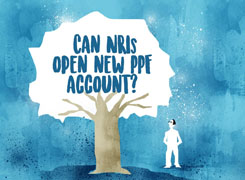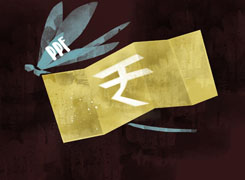PPF Panic: Trouble withdrawing my minor daughter's college fund?
Ramalingam Kalirajan |10881 Answers |Ask -Follow
Mutual Funds, Financial Planning Expert - Answered on Jun 02, 2025
He has an MBA in finance from the University of Madras and is a certified financial planner.
He is the director and chief financial planner at Holistic Investment, a Chennai-based firm that offers financial planning and wealth management advice.... more

Dear Sir.. I have been putting money in my minor daughter's PPF account since 2009. The idea was to meet expenditure for her college education, now the total is about 40 lkhs.I have never claimed any tax benefits on my daughter's PPf account though I am the official guardian of my daughter ,she is now 17.4 yrs old. I have a PPF account in my name. Now for her college admission I need the money for which I have been saving but I am being told the moment I fill Form C & the money gets credited to SB account I can be in a major trouble for having 2 PPF accounts. I am being advised to keep it as it is & pay her 1st year fees from other savings. Next year when she turns 18 /major make a PAN card for her, open a SB account in her name & make the PPF withdrawl to that account. Request your advise if the fear of trouble if I withdraw as minor's guardian is genuine & if she does it next year there will be no issue.
Now, as her college admission is near, your concern about the withdrawal is natural. Many parents face similar confusion at this stage.
Let us understand the issue in full detail and guide you clearly.
Basic Rule – One PPF Account per Individual
As per rules, an individual is allowed only one PPF account in their name.
A guardian can open only one PPF account per minor child.
The guardian can also have one PPF account in their own name.
So, if you have only one PPF in your name and one for your daughter (as a minor), that is allowed.
There is no rule violation in holding both.
Problem only arises if you open more than one PPF for the same person or more than one minor account for same child.
Since you opened just one for her and one for yourself, you are well within rules.
So far, there is no need to panic. You have not violated the rules till now.
Guardian’s Role in Minor PPF – Key Points
As the official guardian, you are legally allowed to open and operate the PPF account of your daughter.
You can make contributions, withdrawals, and handle all paperwork till she turns 18.
Even though you never claimed tax benefits, that does not change the legal status.
Tax benefit claim is optional. It does not impact the account legality.
What matters is that you operated the account as a guardian, not as owner.
Till she becomes major, all operations must be through guardian.
Withdrawal Rules from Minor’s PPF
A guardian can withdraw from minor’s PPF account using Form C.
The withdrawal should be for the benefit of the minor child.
Since you are using the funds for her higher education, the purpose is valid.
It is best to keep evidence of college admission and fee payment.
This supports your claim that money is being used for her.
You may withdraw and transfer to your SB account as guardian.
From there, you may pay the college fee.
There is no rule that says it must be transferred to minor’s SB account.
There is no restriction in using guardian’s SB account for benefit of the minor.
Why Some Banks Create Confusion
Many bank officials are not fully aware of PPF rules.
They may raise concerns fearing rule violations.
Some over-cautious staff discourage guardian withdrawals to avoid responsibility.
But such caution is unnecessary if all documents are in order.
What matters is that money is used for child’s benefit.
Also, remember that rules are with Ministry of Finance, not individual banks.
Bank is only a facilitator, not the authority.
So you can educate them with proper clarity if needed.
What Happens When Child Turns Major?
Once your daughter turns 18, she becomes the legal holder of the PPF.
You, as guardian, lose rights to operate the account.
A formal application must be made to change status from minor to major.
This includes her PAN, signature, and KYC details.
A new SB account in her name is also required.
From that point, she handles the PPF independently.
You can’t withdraw or contribute as guardian after she becomes adult.
Once updated, she may operate and withdraw money herself.
There is no legal issue in this process.
Should You Wait Till She Turns 18?
If the fee can be managed from other funds this year, waiting is safer.
Once she turns major, you can transfer funds to her account directly.
That avoids any conflict or confusion at bank branch level.
You can ensure better compliance and reduce chances of being questioned.
If first-year fee is urgent and cannot wait, you can still withdraw now as guardian.
Keep documents and payment receipts ready.
Attach a declaration that this is for her education purpose.
That acts as a proper safeguard in case of any query.
There is no penalty for guardian withdrawal if done properly.
What Not To Do
Do not withdraw the full amount unless needed.
Withdraw only the required amount for now.
Avoid large lump-sum transfers to your account unless needed.
That may raise questions from income tax or bank compliance teams.
Avoid cash withdrawal. Always use digital transfer to pay college fee.
Do not close the account unless absolutely necessary.
Even after age 18, she may continue with PPF if needed.
What to Do Next Year When She Turns 18
Apply to bank to convert PPF status from minor to major.
Provide her PAN card, Aadhar card, and signature specimen.
Open a new SB account in her name if not already.
Submit application to update records at PPF branch.
Once status is updated, she becomes the account operator.
From then, all deposits and withdrawals should be in her name.
No need to worry about any guardian signature after that.
This way, you remain fully compliant.
You can guide her on how to use the money wisely.
Do Not Worry About Tax Scrutiny
Many parents fear income tax notice for multiple PPF accounts.
But in your case, you did not break rules.
One PPF in your name and one as guardian is allowed.
You never claimed tax benefit for her account, which further reduces scrutiny.
Also, the PPF amount is tax-free on maturity.
So there is no tax event at time of withdrawal.
Only care needed is to use it for child’s benefit.
That keeps your position strong and fully in control.
Your Planning is Highly Appreciated
You started this savings when she was very young.
You continued it with discipline for over a decade.
Now, it is fulfilling the purpose it was meant for.
Many parents fail to plan so early.
Your approach is a model for others.
Do continue to guide your daughter on how to save and plan too.
Final Insights
You are well within the rules. No panic is needed.
Guardian withdrawal is legally allowed if for child’s use.
If possible, wait till she turns 18 for full withdrawal and clarity.
Else, withdraw now with proper documents and use.
Avoid misinformation or fear from bank staff.
You have planned well. Now execute it smoothly.
Help your daughter take control of her finances from here.
Encourage her to continue investing after college too.
That ensures financial independence and peace for her future.
Best Regards,
K. Ramalingam, MBA, CFP,
Chief Financial Planner,
www.holisticinvestment.in
https://www.youtube.com/@HolisticInvestment
You may like to see similar questions and answers below
T S Khurana |536 Answers |Ask -Follow
Tax Expert - Answered on Aug 31, 2024
Ramalingam Kalirajan |10881 Answers |Ask -Follow
Mutual Funds, Financial Planning Expert - Answered on May 29, 2024
T S Khurana |536 Answers |Ask -Follow
Tax Expert - Answered on Oct 30, 2024
T S Khurana |536 Answers |Ask -Follow
Tax Expert - Answered on Nov 12, 2024
Milind Vadjikar | Answer |Ask -Follow
Insurance, Stocks, MF, PF Expert - Answered on Nov 19, 2024
Dr Dipankar Dutta |1839 Answers |Ask -Follow
Tech Careers and Skill Development Expert - Answered on Dec 13, 2025
Dr Dipankar Dutta |1839 Answers |Ask -Follow
Tech Careers and Skill Development Expert - Answered on Dec 13, 2025
Mayank Chandel |2575 Answers |Ask -Follow
IIT-JEE, NEET-UG, SAT, CLAT, CA, CS Exam Expert - Answered on Dec 13, 2025
Radheshyam Zanwar |6742 Answers |Ask -Follow
MHT-CET, IIT-JEE, NEET-UG Expert - Answered on Dec 13, 2025
Mayank Chandel |2575 Answers |Ask -Follow
IIT-JEE, NEET-UG, SAT, CLAT, CA, CS Exam Expert - Answered on Dec 13, 2025
Mayank Chandel |2575 Answers |Ask -Follow
IIT-JEE, NEET-UG, SAT, CLAT, CA, CS Exam Expert - Answered on Dec 13, 2025
Kanchan Rai |646 Answers |Ask -Follow
Relationships Expert, Mind Coach - Answered on Dec 12, 2025
Ravi Mittal |677 Answers |Ask -Follow
Dating, Relationships Expert - Answered on Dec 12, 2025
Ramalingam Kalirajan |10881 Answers |Ask -Follow
Mutual Funds, Financial Planning Expert - Answered on Dec 12, 2025
Ramalingam Kalirajan |10881 Answers |Ask -Follow
Mutual Funds, Financial Planning Expert - Answered on Dec 12, 2025


























